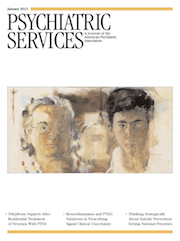News Briefs
Guide to help employers comply with parity law: The Mental Health Parity and Addiction Equity Act of 2008 (MHPAEA) requires group health plans that cover more than 50 employees and that offer coverage for mental or substance use disorders to provide such coverage at parity with medical-surgical benefits with respect to financial requirements and treatment limitations. The law, which is estimated to affect 113 million people, including 82 million enrolled in self-insured plans, and the detailed regulations for implementing it can be confusing and can make compliance a difficult and time-consuming task. At the request of the Partnership for Workplace Mental Health, a subsidiary of the American Psychiatric Association, Milliman, Inc., has prepared a reference document designed to help employers understand MHPAEA requirements and how to assess compliance with the parity tests and standards embedded in the law and regulations. The 30-page guide, Employer Guide for Compliance With the Mental Health Parity and Addiction Equity Act, provides a series of questions that the employer’s health plan can use to conduct a thorough assessment of the plan’s compliance with MHPAEA. The guide is available at www.workplacementalhealth.org/erguide.
KCMU report on Medicaid spending on home- and community-based services: As states implement aspects of the Affordable Care Act (ACA), developing and expanding home and community-based alternatives to institutional care remains a priority for many state Medicaid programs. Most Medicaid spending on long-term services and supports for low-income seniors and people with disabilities is for institutional care; however, the percentage spent on home- and community-based services (HCBS) has more than doubled—from 20% in 1995 to 45% in 2010. A new report from the Kaiser Commission on Medicaid and the Uninsured (KCMU) examines the most current data on efforts by state Medicaid programs to expand HCBS. The 44-page report, Medicaid Home and Community-Based Service Programs: 2009 Data Update, summarizes key trends in expenditures and participation data for the three main Medicaid HCBS programs—the mandatory home health services state plan benefit, the optional personal care services state plan benefit, and optional Section 1915(c) HCBS waivers services—and describes policies shaping the administration of these programs. About 3.25 million people were served by HCBS programs in 2009, at a cost of $50 billion. Per-person spending averaged $15,371, although there was considerable variation among states and programs. The full report is available on the KCMU Web site at www.kff.org/medicaid/7720.cfm.
NSDUH data show 20% of adults had a past-year mental illness: One in five American adults age 18 and older, or 45.6 million people, had a mental illness in the past year, according to a report from the Substance Abuse and Mental Health Services Administration (SAMHSA), Results From the 2011 National Survey on Drug Use and Health (NSDUH): Mental Health Findings. The rate of mental illness was more than twice as high among adults age 18 to 25 (29.8%) than among those age 50 and older (14.3%). Adult women were more likely than men to have had mental illness in the past year (23.0% versus 15.9%). The survey defined mental illness as having had a diagnosable DSM-IV mental, behavioral, or emotional disorder (excluding developmental and substance use disorders) in the past year. Survey data also indicated that 11.5 million adults (5% of the adult population) had a serious mental illness in the past year, defined as a mental illness that resulted in serious functional impairment that substantially interfered with or limited one or more major life activities. Conducted by the federal government since 1971, the survey collects data through face-to-face, in-home interviews with approximately 65,750 people aged 12 years and older nationwide. The complete survey findings are available on the SAMHSA Web site at www.samhsa.gov/data/NSDUH/2k11MH_FindingsandDetTables/index.aspx.



